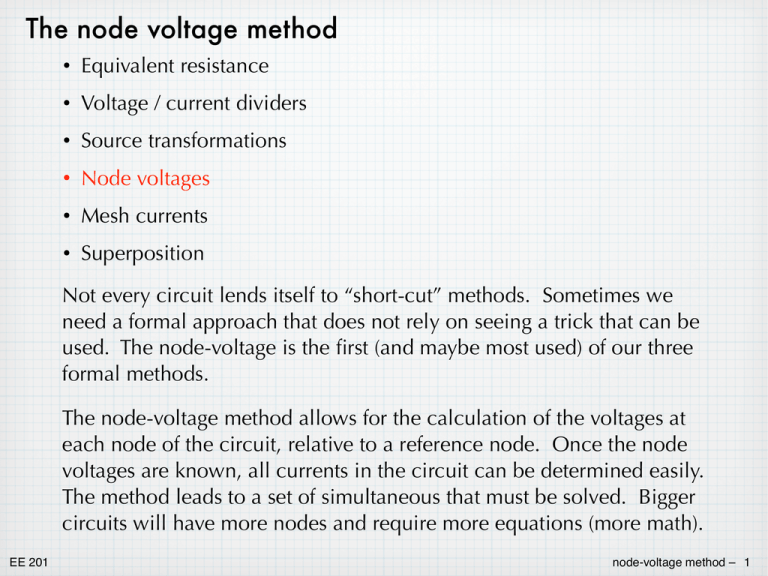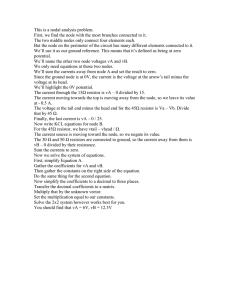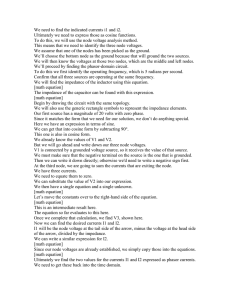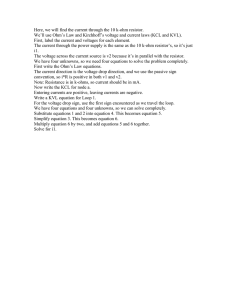The node voltage method
advertisement

The node voltage method • Equivalent resistance • Voltage / current dividers • Source transformations • Node voltages • Mesh currents • Superposition Not every circuit lends itself to “short-cut” methods. Sometimes we need a formal approach that does not rely on seeing a trick that can be used. The node-voltage is the first (and maybe most used) of our three formal methods. The node-voltage method allows for the calculation of the voltages at each node of the circuit, relative to a reference node. Once the node voltages are known, all currents in the circuit can be determined easily. The method leads to a set of simultaneous that must be solved. Bigger circuits will have more nodes and require more equations (more math). EE 201 node-voltage method – 1 Recall: IS iVS1 IS2 R1 a VS1 + – iR1 b R2 R3 iR2 iR3 c iVS2 + VS2 – d Using KCL at each node: a: b: c: d: EE 201 = + = = + = 4 equations, but 5 unknowns (iVS1, iVS2, iR1, iR2, and iR3). Need more info. Or a better method. + + node-voltage method – 2 The node voltage method Look at an example. R1 VS 10 V + – 10 ! R2 5! IS 1 A Step 1 - Identify all of the nodes in the circuit. a VS + – R1 b R2 IS c This small circuit has three nodes. In principle, three unknown voltages, but we will try to reduce this. EE 201 node-voltage method – 3 Step 2 - Choose one node to be the reference, usually called ground. Since voltage is a relative quantity (only voltage differences matter), we can choose one point in the circuit to be V = 0. The voltages at the other nodes will be with respect this ground node. a VS + – R1 b R2 IS vc = 0 In general, we can choose any node as the reference, but some choices are better than others. Typically, we should choose a node that is connected to the positive or negative terminal of a voltage source. For this circuit, that implies node a or node c. This time, we choose node c, so we can now say vc = 0. EE 201 node-voltage method – 4 Step 3 - Identify any other nodes for which the voltages (with respect to ground) are known. va = V S VS + – R1 b R2 IS vc = 0 For this circuit, the voltage source tells us that node a is VS higher in voltage than the ground node. Therefore va = VS. Since the voltage at a is now known, we have reduced the number of unknowns down to one – the voltage at node b. EE 201 node-voltage method – 5 Step 4 - Look for other ways (like resistor reductions) that could be used to reduce the number of unknown voltages further. It is not necessary to calculate the voltage at every node. If we can eliminate non-essential nodes, we should do so. In this example, we are already down to one node – not much more we can do. Step 5 - Assign voltage variables to each of the remaining unknown nodes. va = VS VS + – R1 vb R2 IS For this example, there is only one unknown node voltage. vc = 0 EE 201 node-voltage method – 6 Step 6 - Assign currents to all the branches connected to each of the unknown nodes. You are at liberty to choose whatever directions you want for the current arrows. R1 va = VS VS + – iR1 IS vb R2 iR2 IS vc = 0 Step 7 - Use KCL to write equations balancing the currents at each unknown node. iR1 + IS = iR2 Step 8 - Use Ohm’s law to express the resistor currents in terms of the node voltages on either side of the resistor. Pay attention to polarity! = EE 201 = node-voltage method – 7 Step 9 - Substitute the Ohm’s law expressions for the resistor currents into the KCL equations to form the node-voltage equations. + = The circuit analysis is done. The rest is just math. Step 10 - Solve the equation(s). + + = = = + = + + +( + )( ) = . Finally, the resistor voltages and currents (using Ohm’s law) can be calculated. = = EE 201 = = . . = . = . = = = . = . = . node-voltage method – 8 node-voltage method – summary 1. Identify all of the nodes in the circuit. 2. Choose one node to be ground. 3. Identify nodes for which the voltage is known due to sources. 4. Use resistor reductions to eliminate any other non-essential nodes. 5. Assign variables for the voltages at the remaining unknown nodes. 6. Assign currents to all of the branches connected to the nodes. 7. Write KCL equations balancing the currents at each of the nodes. 8. Use Ohm’s law to express resistor currents in terms of the (unknown) node voltages on either side of the resistor. (Be sure to get the correct polarity!) 9. Substitute the resistor currents into the KCL equations to form the node-voltage equations. (Set of equations relating the unknown node voltages.) 10.Do the math to solve the equations and determine the node voltages. Determine currents, powers, etc., if needed. EE 201 node-voltage method – 9 Example Same circuit, but choose a different ground. 1. Identify the nodes. a VS 10 V + – R1 b 10 ! R2 5! IS 1 A c 2. Choose one to be ground. This time, choose node a. va = 0 VS + – R1 b R2 IS c EE 201 node-voltage method – 10 3. Identify nodes for which the voltage is known. Clearly, va – vc = VS. Therefore, vc = – VS. va = 0 VS R1 + – b R2 IS vc = –VS 5&6. Assign variables for the unknown voltages. Assign currents for each branch connected to the nodes. va = 0 VS EE 201 + – R1 iR1 IS vb R2 iR2 vc = –VS IS node-voltage method – 11 7. Write KCL equations balancing the currents at each node. va = 0 VS + – R1 IS vb iR1 R2 IS iR2 vc = –VS iR1 + IS = iR2 8. Use Ohm’s law to express the resistor currents in terms of the node voltages. = = ( ) 9. Substitute resistor current equations into the KCL equations to form the node-voltage equations. + EE 201 = + node-voltage method – 12 10. Solve it. + = + = + = = + + + = ( )( ) + = . At first glance, this seems wrong – vb here is different from its value in the previous calculation. But remember that only voltage differences matter. In choosing a different reference node, all other node voltages will be shifted accordingly. vR1 = VS – vb = 3.33 V and vR2 = vb – 0 = 6.67 V, in both cases. The corresponding currents will be the same, as well. EE 201 node-voltage method – 13 another example VS1 + – 10 V R1 R3 1 k! 5 k! R2 3 k! IS 5 mA + – R3 c VS2 20 V 1. Identify the nodes. a VS1 + – R1 b R2 IS + – VS2 d EE 201 node-voltage method – 14 2. Choose one to be ground. Since there are voltage sources connected to d, that would seem to be a good choice. 3. Identify nodes for which the voltage is known. With d as ground, then we see that va = VS1 and vc = VS2. va = VS1 VS1 + – R1 R3 b R2 IS vc = VS2 + – VS2 Only one node left, so only one unknown voltage to be found. EE 201 node-voltage method – 15 5&6. Assign a variable for the unknown voltage. Assign currents for each branch connected to the node. va = VS1 R1 VS1 + – iR1 R3 vb R2 iR2 IS iR3 vc = VS2 + – VS2 7. Write KCL equations balancing the currents at the node. + + = 8. Express the resistor currents in terms of the node voltage. = EE 201 = = node-voltage method – 16 9. Substitute resistor currents into the KCL equation to form the node-voltage equation. + + = 10. Solve it. + + ( )+( = ( . = EE 201 + + = )+( = + )( + )= + + ) . node-voltage method – 17 Example In the circuit below, we might like to find the currents of the resistors. The resistor that bridges across the top makes the short-cut methods unusable. R3 30 ! R1 10 ! R2 R4 20 ! 40 ! VS + – 100 V 1. Identify the nodes. x R1 EE 201 R5 50 ! R3 R2 y VS + – g R4 z R5 node-voltage method – 18 2. Choose one to be ground. Due to the single voltage source, the bottom node seems to be a likely choice. 3. Identify nodes for which the voltage is known. With g as ground, then we see that vy = VS. R3 x R1 R2 vy = VS R4 z R5 VS + – vg = 0 EE 201 node-voltage method – 19 5&6. Assign a variable for the unknown voltage. Assign currents for each branch connected to the node. R3 R2 vx R1 iR2 iR1 iR3 VS + – R4 iR4 vz 2 nodes this time! R5 iR5 7. Write KCL equations balancing the currents at the node. x: = + z: + = 8. Express the resistor currents in terms of the node voltages. = EE 201 = = = = node-voltage method – 20 9. Substitute resistor currents into the KCL equations to form the node-voltage equations. x: = z: + + = 10. Solve the equations = + + + + + = = + + = 3.667vx – 0.667vz = 100 V + + + EE 201 = + + = -1.333vx +3.133vz = 100 V vx = 35.85 V and vz = 47.175 V node-voltage method – 21 Final example (a big one) Again, we might like to know how much power is being generated and dissipated in the various elements for the circuit below. Our short-cut methods are useless here, but the node-voltage works in exactly the same manner as the previous examples. The math is a bit more tedious for a bigger circuit – there will be 3 equations in 3 unknowns in this case – but the method is still straight forward. R3 50 ! R1 10 ! VS EE 201 + 15 V – R4 20 ! R2 20 ! IS1 0.25 A R5 30 ! R6 40 ! IS2 0.5 A node-voltage method – 22 1. Identify the nodes. 2. Choose one to be ground. (The bottom one is good, again.) 3. Identify known node voltages. (The left-most node is obviously at VS.) 4. Assign variable names to the remaining, unknown nodes. 5. Assign resistor currents in each branch. R3 va = V S a VS + – vb R4 iR4 vc R5 b c R1 iR1 iR3 R2 iR2 vd iR5 IS1 e d R6 iR6 IS2 ve = 0 EE 201 node-voltage method – 23 iR3 R3 vb R4 iR4 R1 VS iR1 + – R2 vc R5 iR5 IS1 iR2 vd R6 IS2 iR6 7. Write KCL equations balancing the currents at the node. = + + = + = + 8. Express the resistor currents in terms of the node voltages. 9. Substitute resistor currents into the KCL equations. = + + + EE 201 = = + node-voltage method – 24 10. Solve the equations = + + + + = + + + . + . + . + + = + = = . = = Two web-site solvers: EE 201 + = + . = vb = 9.554 V vc = 8.217 V" vd = 13.709 V http://math.bd.psu.edu/~jpp4/finitemath/3x3solver.html http://www.1728.org/unknwn3.htm node-voltage method – 25



